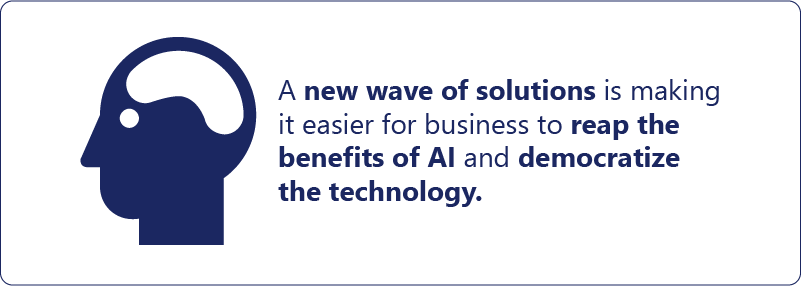7-minute read
As we look at the year 2020 in the rearview mirror (thank goodness) and think about digital transformation in 2021, the first word that comes to my mind is accelerated. In businesses across all industries, the unprecedented challenges of last year forced digital roadmaps to be rapidly redrawn, digital toolboxes to be urgently refurbished, and digital transformation initiatives to go into hyperdrive.
When the 2020 coronavirus pandemic forced people to isolate in their homes and businesses to minimize personal contact with customers, organizations were driven to hit the accelerator on their digital transformation efforts. The shift to a work-from-home workforce, as Gartner puts it, caused many organizations “to vault years forward in the space of a few weeks.” And the shift from in-person to digital services led to similarly dramatic shifts in healthcare (telemedicine), retail (online ordering), financial services (online/mobile banking), and other industries.
In adapting to this dramatically different environment, businesses that had already invested in digital transformation had the advantage of a head start over those that had not. Those that were reluctant to embrace the digital mandate found themselves scrambling to piece together a digital strategy with hastily acquired assets.
And businesses that long for a restoration of business-as-usual are coming to a grim realization that returning to the pre-pandemic status quo is not an option. Even after the crisis passes and restrictions are lifted, employees will want to continue having the option to work from home, and consumers who have become used to digital conveniences will continue to expect their availability.
As we enter 2021, our task is to rebuild the disrupted digital roadmaps and re-establish the vision of digital transformation that will take us into the future. We’ve identified five trends that provide some insight into what that vision will entail.
Digital Transformation Trend #1: Revisiting digital roadmaps
The lockdowns and social distancing requirements that arose during the pandemic presented businesses with a unique challenge—how to leverage their digital toolboxes to minimize personal contact while continuing to serve customers. Organizations that had traditionally relied on face-to-face interactions were required to pivot to an “online first” model and implement the tools needed to support all aspects of a very different customer journey.

Take, for example, the case of certification testing. To ensure the integrity of the process, organizations have traditionally relied on closely supervised in-person testing at designated test centers. When COVID lockdowns made this impossible, tests had to be administered online … but this approach raises a series of additional questions, such as how to verify the identity of test-takers and how to prevent testers from accessing online resources or receiving help from other individuals during the exam. So in addition to an online testing platform, organizations need verification and monitoring capabilities to ensure testing integrity. And of course, everything needs to integrate seamlessly with their existing architecture.
In the product engineering that will enable adjustments to digital roadmaps, we believe we will see closer collaboration between IT and lines of business, a “democratization of innovation” that enables business and IT teams to partner in driving digital transformation. Gartner predicts that by 2024, 75 percent of large enterprises will be using four or more low-code development tools for IT and “citizen” development, and low-code application development will account for more than 65 percent of application development activity.
Digital Transformation Trend #2: Transforming customer service capabilities—internal and external
When the pandemic hit and lockdowns began in March 2020, customer service centers were flooded with inquiries and requests, while at the same time agents were pivoting to a work-from-home operational model. As a result, some wait times extended into multiple hours while call resolution rates dropped to near zero.

This crisis was a wake-up call for customer service organizations that had been slow to embrace digital transformation—or ignored it altogether. When the demand for service overwhelms the organization’s capacity to resolve issues via traditional means, such as the 1:1 customer-to-agent phone call, a new approach to capacity management is required.
Solutions such as messaging, speech-to-text, self-service applications, and virtual agents provide contact centers with flexibility in capacity management while also broadening customers’ options in how they interact with the business. As my colleague Amit Unadkat puts it, “The customer care model of the future reallocates the priority of its various channels as needed to optimize its response to customer needs with maximum flexibility.”
Digital Transformation Trend #3: Taking advantage of intelligent automation
Last year’s “one-two punch” of pandemic and recession required businesses to reevaluate how they approach the processes that make up their day-to-day operations. Health and safety regulations required new workplace rules to minimize contact between employees, while the economic slowdown forced many businesses to cut budgets and reduce headcounts. With these changes came also the realization that another pandemic—or similarly disruptive event—could easily happen again, and by building in resilience and agility today, businesses can be better prepared for future crises.

With business-as-usual no longer an option for any department, many organizations are turning to AI- and ML-driven solutions to keep operations moving while adapting to the new realities. Robotic process automation (RPA) and other automation technologies are nothing new, but the rapid redrawing of business parameters that occurred last year has compelled many organizations to accelerate adoption of these solutions and inject AI into new areas where it can go beyond classic rule-based automation.
Whereas earlier applications of AI and ML focused on automation of individual tasks, we are now seeing an evolution in the direction of process-based automation (automating a series of tasks within a process) and functional automation (automation that spans multiple processes). Organizations that are more advanced in their AI journeys are even moving towards automation at the level of the business ecosystem.
While the benefits automation at the task level are well known, those advantages pale in comparison to what is now possible at higher levels. By taking advantage of AI- and ML-driven solutions today, organizations position themselves to reap ever greater rewards as this evolution continues.
Digital Transformation Trend #4: Accelerating transition to the cloud with SaaS
As COVID-driven health and safety regulations relocated employees from the office to their homes for everyday work, businesses increased reliance on cloud-based solutions. In a June 2020 survey of 250 IT leaders, 82 percent said they had increased their use of cloud-based services in direct response to the pandemic, and 60 percent said their use of off-premise technologies had continued to increase since then.

Prior to last year, the benefits of SaaS were already well known among IT leaders. When COVID ushered in a massive shift to a work-from-home model, businesses that had been reluctant to adopt (or expand) transitions to the cloud were suddenly under pressure to push those changes through. Plus, as we discussed above, the COVID crisis demonstrates that business agility and flexibility are more than just nice-to-haves, and the scalability of SaaS solutions such as Salesforce, ServiceNow, and C3.ai offer distinct advantages in building a more nimble organization.
Another trend we are seeing as part of this pursuit of greater flexibility is a growing interest in multicloud computing. Organizations can pick and choose the cloud provider that best fits their needs for a particular purpose and negotiate volumes and prices accordingly, while also avoiding being locked in with a single vendor. According to a Gartner survey, 81 percent of public cloud users are working with two or more cloud providers. As Gartner VP Analyst Michael Warrilow commented,
“Most organizations adopt a multicloud strategy out of a desire to avoid vendor lock-in or to take advantage of best-of-breed solutions … We expect that most large organizations will continue to willfully pursue this approach.”
Digital Transformation Trend #5: Leveraging AI as a service
As adoption of smart automation (see trend #3) and SaaS solutions (see trend #4) grows in 2021, we believe we’ll see an intersection of those trends as more organizations implement AI as a service.

More solutions are providing machine learning models out of the box, reducing the level of skills needed for organizations to take advantage of AI. A new wave of solutions is making it easier for business to reap the benefits of AI and democratize the technology. By implementing solutions such as C3.ai, with model-driven architecture and low-code AI applications, DataRobot, with an ML model bank allowing users to test and optimize their predictions, and Applause, with crowdsourced datasets to train AI models, more businesses have the opportunity to implement AI more quickly and with significantly less training than earlier approaches required.
Looking ahead
As challenging as the previous year was on multiple levels, we can say that the historic events of 2020 ushered in a leap forward in the drive towards digital transformation. Organizations that had resisted adopting a digital-first model faced the choice of moving forward or falling behind their competitors (and their customers’ expectations). Now that the business community has the opportunity to take a breath and determine next steps, look for these five trends to have a significant impact as the business ecosystem of the future begins to take shape.

Digital transformation done right
We create powerful custom tools, optimize packaged software, and provide trusted guidance to enable your teams and deliver business value that lasts.

Lionel Bodin is the Director of Digital Transformation at Logic20/20. He manages highly complex, multi-faceted digital programs related to CRM systems, cloud and on-prem implementations, big data, and more.

